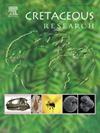Unique conifer assemblage from Late Jurassic-Early Cretaceous deposits (NE Brazil) unveils the paleoclimate and paleobiogeography in the interior of equatorial Gondwana
IF 1.7
3区 地球科学
Q1 GEOLOGY
引用次数: 0
Abstract
The Brazilian paleoxyloflora conspicuously lacks a robust Late Jurassic-Early Cretaceous record. However, several fossil woods have been reported since the 18th century from the Upper Jurassic to Lower Cretaceous deposits of Missão Velha Formation, Araripe Basin, northeastern Brazil, although no taxonomic and systematic analysis has been carried out so far. Here, we provide the first taxonomic and systematic study of these fossil woods, utilizing them for paleoclimatic and paleobiogeographic inferences for this region in equatorial Gondwana. We thus describe a new fossil-species, Metapodocarpoxylon brasiliense, and document, for the first time, the presence of Agathoxylon mendezii in Brazil. They are distinguished by characters of radial pit arrangement, cross-field pits, presence of resin plugs, axial parenchyma, septate tracheids, and ray seriation and height. These fossil-genera have been previously observed in other Mesozoic paleoxylofloras of Gondwana, being Metapodocarpoxylon, in particular, restricted to the tropical belt and coastal areas, and its occurrence in Brazilian paleofloras is unknown to date. Its new occurrence suggests a migration of this element of the paleovegetation towards inland areas likely triggered by paleoclimatic changes from the Late Jurassic onwards. The presence of indistinct and distinct growth rings with narrow latewood in the conifer assemblage suggests a moderately seasonal paleoclimate with rainy and dry seasons, which is also supported by the geological data, probably stimulated by the monsoonal regime in the basinal area. The new wood records, combined with geological and paleoclimatological background information and palynological data obtained from the study area in the early 2000’s allowed for a preliminary reconstruction of a segment of the landscape during deposition of the Missão Velha Formation.

晚侏罗世-早白垩世(巴西东北部)独特的针叶树组合揭示了赤道冈瓦纳内陆的古气候和古生物地理
巴西古植物区系明显缺乏一个健全的晚侏罗世-早白垩世记录。然而,自18世纪以来,在巴西东北部Araripe盆地的miss o Velha组的上侏罗统至下白垩统沉积物中发现了一些化石木,尽管迄今尚未进行分类和系统分析。本文首次对这些森林化石进行了分类和系统的研究,并利用它们对赤道冈瓦纳地区的古气候和古生物地理进行了推断。因此,我们描述了一个新的化石物种,Metapodocarpoxylon brasiliense,并首次记录了Agathoxylon mendezii在巴西的存在。它们的特征是径向凹坑排列、交叉凹坑、树脂塞的存在、轴向薄壁、隔生管胞、射线序列和高度。这些化石属曾在冈瓦纳其他中生代古植物区系中发现,特别是在热带和沿海地区发现的Metapodocarpoxylon,在巴西的古植物区系中尚未发现。它的新发现表明,这部分古植被向内陆地区的迁移可能是由晚侏罗世以来的古气候变化引发的。针叶树群落中生长年轮不明显、年轮较窄,表明其古气候为雨季和旱季,地质资料也支持这一观点,可能是受海盆地区季风气候的影响。新的木材记录,结合2000年代初从研究区获得的地质和古气候背景信息以及孢粉学数据,可以初步重建miss o Velha组沉积时期的一段景观。
本文章由计算机程序翻译,如有差异,请以英文原文为准。
求助全文
约1分钟内获得全文
求助全文
来源期刊

Cretaceous Research
地学-地质学
CiteScore
4.10
自引率
19.00%
发文量
235
审稿时长
12 weeks
期刊介绍:
Cretaceous Research provides a forum for the rapid publication of research on all aspects of the Cretaceous Period, including its boundaries with the Jurassic and Palaeogene. Authoritative papers reporting detailed investigations of Cretaceous stratigraphy and palaeontology, studies of regional geology, and reviews of recently published books are complemented by short communications of significant new findings.
Papers submitted to Cretaceous Research should place the research in a broad context, with emphasis placed towards our better understanding of the Cretaceous, that are therefore of interest to the diverse, international readership of the journal. Full length papers that focus solely on a local theme or area will not be accepted for publication; authors of short communications are encouraged to discuss how their findings are of relevance to the Cretaceous on a broad scale.
Research Areas include:
• Regional geology
• Stratigraphy and palaeontology
• Palaeobiology
• Palaeobiogeography
• Palaeoceanography
• Palaeoclimatology
• Evolutionary Palaeoecology
• Geochronology
• Global events.
 求助内容:
求助内容: 应助结果提醒方式:
应助结果提醒方式:


